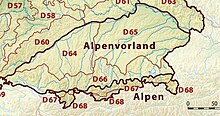Alpine Foreland

The Alpine Foreland,[1] less commonly called the Bavarian Foreland,[1] Bavarian Plateau[1] or Bavarian Alpine Foreland (German: Bayerisches Alpenvorland), refers to a triangular region of plateau and rolling foothills in Southern Germany, stretching from Lake Constance in the west to beyond Linz on the Danube in the east, with the Bavarian Alps forming its south boundary and the Danube its northern extent.[1]
Geography
The Alpine Foreland has been shaped under the influence of the
glaciation
stages in this region.
The Alpine Foreland is crossed by the rivers
Inn, its western boundary roughly being formed by the border of the Bavarian administrative district of Swabia with the State of Baden-Württemberg, and its eastern boundary being the Salzach river on the border with Austria. The numerous lakes include Lake Constance, Lake Starnberg and Chiemsee. The largest cities of the region are Munich, located in the centre of the Alpine Foreland on the River Isar, and Augsburg
, located in the very centre of Southern Germany on the river Lech.
Classification

According to the Handbook of Natural Region Divisions of Germany, the Alpine Foreland is commonly subdivided into three natural regions:
- Northern Alpine Foreland:
- Iller-Lech Plateau (D64) south of the Swabian Jura range
- Lower Bavarian Upland (D65) south of the Franconian Jura and Bavarian Forest (Bohemian Massif)
- Southern Alpine Foreland (D66) at the foot of the Northern Limestone Alps
In the west, the Alpine Foreland stretches along the Danube up to its sources in the
Salzburg, the adjacent Innviertel, Hausruckviertel and Traunviertel of Upper Austria, as well as the Mostviertel region of Lower Austria up to the Tulln
Basin.
